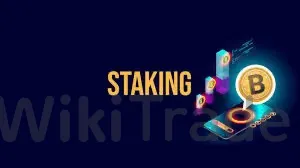NFT Staking Definition
Abstract: In the ever-evolving world of digital assets, NFT staking has emerged as an innovative way to earn rewards by locking up your unique digital collectibles. This process is akin to earning interest on a bank deposit or mining in the crypto space, but with a twist: you're staking non-fungible tokens (NFTs) instead of coins.
What is NFT Staking?
NFT staking allows NFT owners to deposit their digital assets into a specific platform or contract to earn rewards. These rewards can be in the form of cryptocurrency, additional NFTs, or exclusive benefits. It's a strategy that transforms NFTs from mere collectibles into income-generating assets, enhancing the liquidity of the NFT market and attracting a wider range of investors.

How Does NFT Staking Work?
Key Steps
- Platform Selection: Choose a platform that supports NFT staking, considering factors like security, variety of supported NFTs, and the underlying blockchain technology.
- Staking NFTs: Transfer your NFTs from your personal wallet to the platform's contract. This doesn't mean you're selling or transferring ownership; it's more like placing assets in a trust for safekeeping.
- Earning Rewards: Once your NFTs are staked, the platform distributes rewards based on the staking agreement.
- Transaction Fee Sharing: Earn a portion of the transaction fees from NFT trades on the platform.
- Platform-Specific Tokens: Some platforms issue their native tokens as rewards, which can be used within the platform ecosystem.
- Other Income-Generating Assets: In more complex ecosystems, staked NFTs can yield additional assets like cryptocurrencies or more NFTs.
- Staking Model: Flexible, with rewards typically in Ether (ETH).
- Yield: May offer lower percentages but compensates with higher liquidity.
- Staking Model: Integrates its native token, RARI, for rewards and governance.
- Yield: Might provide higher yields but with potential volatility.
- Passive Income: Earn rewards on assets that would otherwise remain idle.
- Market Liquidity: Improves liquidity, facilitating easier trading of assets.
- Reduced Holding Costs: Offsets potential costs associated with holding NFTs.
- Market Volatility: The value of NFTs and rewards can fluctuate dramatically.
- Technical Risks: Reliance on smart contracts and blockchain infrastructure can lead to failures or exploits.
- Platform Credit Risk: Trust in the platform is critical; mismanagement can lead to losses.
- Security: Investigate the platform's security measures and history.
- Yield Rates: Compare rates across platforms for the best opportunities.
- User Reviews: Look at other users' experiences for insight into reliability.
- Registration and Wallet Connection: Sign up and link your digital wallet.
- Choosing and Staking NFTs: Select NFTs based on eligibility and potential returns, then transfer them to the staking contract.
- Earning and Withdrawing Yields: Accumulate rewards over time and withdraw them as needed.
- Smart Contract Improvements: Expect advancements in security and efficiency.
- Regulatory Developments: Platforms may need to adapt to new laws and regulations.
- Smart Contract Vulnerabilities: Potential bugs can be exploited.
- Market Volatility: Token value fluctuations affect rewards.
- Liquidity Issues: Staked NFTs are not immediately accessible.
- Regulatory Changes: Unanticipated actions can impact platform operations.
- Security: Look for platforms with rigorous security audits.
- Reputation: Check community feedback and reviews.
- Transparency: Clear details on staking process and fees.
- User Interface: A user-friendly interface with comprehensive tools.

Revenue Sources

Market Overview
The global NFT staking market has seen significant growth, driven by the acceptance of NFTs as legitimate assets and interest in decentralized finance (DeFi). The market is characterized by increasing capitalization and user adoption, with spikes in trading volumes and staking participation during periods of high market activity.

Mainstream Platforms
Opensea

Rarible

Advantages and Risks
Advantages

Risks
How to Get Started
Choosing a Platform
Staking Process
Future Trends
FAQs
How Does NFT Staking Generate Income?
NFT staking generates income by leveraging the value of digital assets in blockchain ecosystem activities. You're rewarded for supporting platform operations, such as transaction validation or powering dApps.
What Are the Risks of Staking NFTs?
How to Choose a Reliable NFT Staking Platform?
Is My NFT Safe After Staking?
The safety of your NFT depends on the platform's security measures. Ensure you're comfortable with the platform's practices before staking.
This guide provides a concise overview of NFT staking, highlighting the key principles, platforms, and considerations for getting started. As the market matures, NFT staking is set to become an increasingly important aspect of the digital asset landscape.




Top News
 WikiTrade
WikiTrade WikiTrade
WikiTrade WikiTrade
WikiTrade WikiTrade
WikiTrade WikiTrade
WikiTrade WikiTrade
WikiTrade WikiTrade
WikiTrade WikiTrade
WikiTrade WikiTrade
WikiTrade WikiTrade
WikiTrade


